|
|
|
|
RELEVANT and
IRRELEVANT
(to
“Introduction to Cosmic Rays”)
|
|
|
Here you may look through
and
download animated pictures and movies
some of which were demonstrated during the lectures.
 Animated Sun Animated Sun
 |
|
|
(from NASA Goddard Space Flight Center)
|
|
|
|
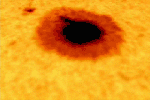
|
Sunspots
appear dark because they are cooler than the solar surface; they can be
as large as 80,000 km (over 6 planet Earths).
 Click on image to open the animation in new window [mpg
format, 2.82 MB]
Click on image to open the animation in new window [mpg
format, 2.82 MB]
|
|
 |
|
|
|
|
|
|
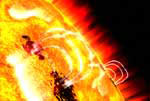
|
Peering
beneath the surface of AR 9393 revealed regions comprised of many small
magnetic structures that rise quickly from deep within the Sun.
 Click on
image to open the animation in new window [mov
format, 11.7 MB]
Click on
image to open the animation in new window [mov
format, 11.7 MB]
|
|
 |
|
|
(from Stanford
Solar Center)
|
|
|
|
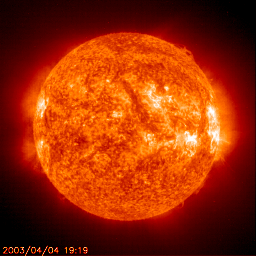
|
A
collection of solar "white light" images from April-May
2003, strung together in an animation. The Sun has artificially
been colored orange.
 Click
on
image to enlarge the animated image in
new window [gif
format, 1.13 MB]
Click
on
image to enlarge the animated image in
new window [gif
format, 1.13 MB]
|
|
 |
|
|
Magnetic
activity in the Sun's
corona
(from the Space Weather
Project, La Trobe
University)
|
|
|
|
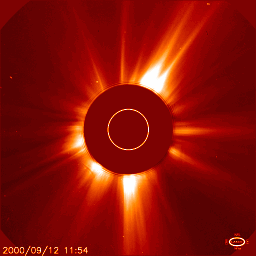
|
The
most prominent features
of the magnetic activity of the Sun's corona are usually the coronal
streamers, nearly radial bands streaming outward. The image shows an
extraordinary powerful solar flare (12/09/2000).
 Click
on image to enlarge the it in new window [gif format, 594 KB]
Click
on image to enlarge the it in new window [gif format, 594 KB]
The real-time movie
of the most recent 48 hours of solar activity can be seen in Space.com. The picture is
updated every hour if satellite communications permit.
|
|
 |
|
The
Day the
Solar Wind Disappeared
(from Views
of the Solar System by Calvin J. Hamilton)
|
|
|
|
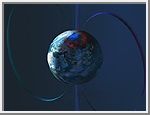
|
As
the
solar wind dissipates on May 11, 1999, the magnetosphere and bow shock
around Earth
expand to five times their normal size. The aurora, which usually forms
ovals around Earth's poles, fills in over the northern polar cap.
 Click
on
image to open the animation in new
window [mov
format, 9.32 MB]
Click
on
image to open the animation in new
window [mov
format, 9.32 MB]
|
|
 |
For
an exceptional
collection of animated pictures of Cosmos visit the official NASA
home page
 |
 |
|
|
and,
in particular, the
following page of the NASA Goddard Center  |
 |
 |
 Animated
Supernovae Animated
Supernovae
 |
|
A
supernova
explosion (artist's
concept)
(from
NASA
HubblSite)
|
|
|
|

|
There
is
an initial flash of light from the supernova explosion causing the ring
to glow. Debris hurls into space, the fastest moving at 0.1c.
The supernova's shockwave causes the ring to glow again.
 Click
on
image to open the movie in new window [mov format, 2.56
MB] Click
on
image to open the movie in new window [mov format, 2.56
MB]
The
closer
the pieces of the ring are to the shockwave, the sooner they light up.
Eventually, the whole ring lights up.
|
 |
|
Supernova
1987A: how the rings are
oriented towards Earth
(from
NASA
HubblSite)
|
|
|
|

|
 Click
on
image to open the movie in new window [mov format, 4.12
MB] Click
on
image to open the movie in new window [mov format, 4.12
MB]
|
|

|
 [mpg
format, 1.24 MB] [mpg
format, 1.24 MB]
|
 |
|
Supernova
1987A: how the rings are
oriented towards Earth
(from Chandra
X-ray Observatory; see also
homepage of Tom Michalik, Randolph-Macon Woman's
College, for more explanations and more images)
|
|
|
|
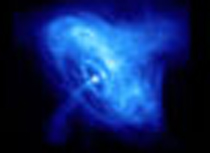
|
The
X-ray
image shows tilted rings or waves of high-energy particles that appear
to have been flung outward over the distance of a light year from the
central star, and high-energy jets of particles blasting away from the
neutron star in a direction perpendicular to the spiral. It provides
important clues to the puzzle of how the cosmic “generator,” a pulsing
neutron star, energizes the nebula, which still glows brightly almost
1,000 years after the explosion.
 Click
on
image to open the movie in new window [mpeg format, 2.37
MB] Click
on
image to open the movie in new window [mpeg format, 2.37
MB]
According
to Martin Weisskopf (NASA's Marshall Space Flight
Center), “The Crab pulsar
is accelerating particles up to the speed of light and
flinging them out into interstellar space at an incredible rate.”
|
 |
|

|
|
 |
 Cosmic ray
acceleration and
propagation in cosmos Cosmic ray
acceleration and
propagation in cosmos
 |
Simulations
of Cosmic Rays from
GRBs in the Galaxy
(by Chuck D. Dermer and Jeremy M. Holmes, U.S.
Naval Research Lab)
|
|
|
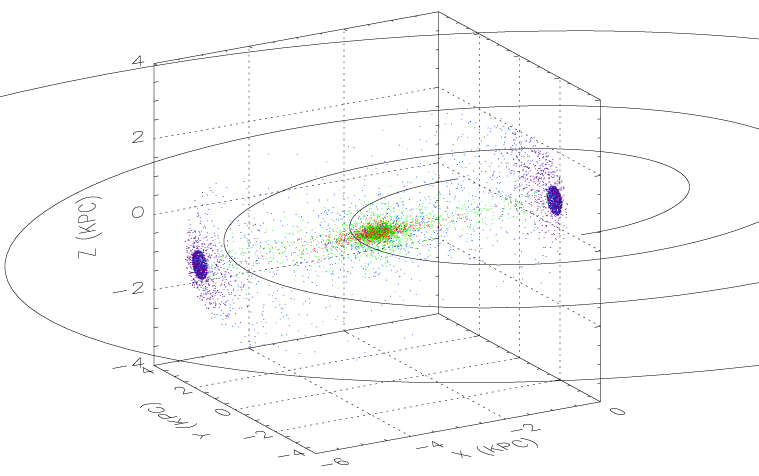 |
CR
halo
formed 12,000 years after a gamma-ray burst that took place at 3 kpc at
the center of the Galaxy.
Legend:
CR protons with Lorentz factors in the ranges 107-8,
108-9, 109-10, and 1010-11 are red,
green, turquoise, and purple, respectively. CR neutrons and neutron-decay protons are dark red, yellow, magenta, and dark blue in
the respective energy ranges.
 Click
on
image to open the animation in new
window [gif
format, 2.71 MB]
Click
on
image to open the animation in new
window [gif
format, 2.71 MB]
|
 |
 Extensive
air showers Extensive
air showers
 |
An
extensive
air shower in the
Pierre Auger Cosmic Ray Observatory Engineering Array
(from
Pierre
Auger homepage)
|
|
|
 |
This
is an artist's view of an
oblique EAS. The shower particles
travel at essentially the speed of light. They spread out from the
shower axis in a thin “shower front.” You can see curvature in the
shape of this front. The moving rectangle is the “shower plane” that is
tangent to the shower front at the shower axis.
 Click
on
image to open the animation in new
window [gif
format, 8.84 MB]
Click
on
image to open the animation in new
window [gif
format, 8.84 MB]
Green
dots
represent electrons and positrons. Red dots represent muons. Notice
that the light detected in a water tank station depends on its distance
from the shower axis. The tank closest to the core gets a much stronger
signal than those that are far from the axis. The arrival direction is
calculated from the shower front arrival times at the different water
tank detectors.
|
 |
CORSIKA
simulated air shower
initiated by a 100 TeV iron nucleus
(by
J. Oehlschläger and Ralf Engel, Institut für Kernphysik,
Forschungszentrum, Karlsruhe)
|
|
|
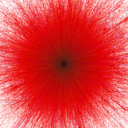 |
This is only one example from a series of animated
extensive air shower images collected in the webpage for the popular
Air Shower Simulation Program CORSIKA.
 Click
on
image to open the animation in new
window [gif
format, 8.38 MB] Click
on
image to open the animation in new
window [gif
format, 8.38 MB]
The
physics
and relevant
references can be found just in the CORSIKA page.
|
 |
CORSIKA
simulated air shower
initiated by a 2 TeV proton
(by
Miguel F. Morales, University of California)
|
|
|
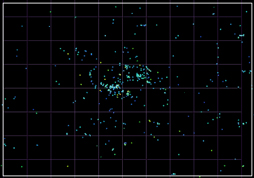 |
This
is
only one example from a series of animated extensive air shower images
collected in the Milagro
Animations web site.
 Click
on
image to open the animation in new
window [mov
format, 8.33 MB]
Click
on
image to open the animation in new
window [mov
format, 8.33 MB]
The
physics
is explained in
this write-up
[M.F. Morales, “Computer
animation of extensive air showers interacting with the Milagro water
Cherenkov detector,” in Proc. of the 6th GeV-TeV
Gamma Ray Astrophysics Workshop “Toward
a Major Atmospheric Cherenkov
Telescope," Snowbird,
Utah, August 13-16, 1999, edited by B.L.
Dingus et
al.; AIP Conf. Proc. 515 (2000) 448-452.]
|
 |
|
(by
Maximo Ave, Dinoj Surendran, Tokonatsu
Yamamoto, Randy Landsberg, and Mark
SubbaRao)
|
|
|
 |
The authors created visualizations of CR showers
by using Sergio Sciutto's AIRES package. The AIRES source code was modified so
it output intermediate particle positions, and these were then
processed with a Perl script to Partiview format. The webpage has downloads of several
showers, and documentation. The showers work in Linux and Windows, and
in side-by-side stereo. From
this page you may start a stroll through
the COSMUS, an “Open Source Science Outreach,” and
then through many other interesting astrophysical sites.
|
 |
 Ultra high
energy cosmic rays Ultra high
energy cosmic rays
 Events
recorded in the AMANDA
Neutrino Telescope Events
recorded in the AMANDA
Neutrino Telescope
(from the AMANDA Wisconsin homepage)
 |
|
|
|
|
|
|
|
|
|
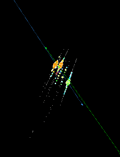 |
|
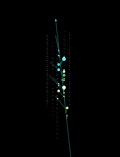 |
|
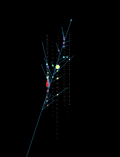 |
|
|
|
# 009377_3d2 |
|
# 910225_y |
|
# 5362470_y |
|
|
|
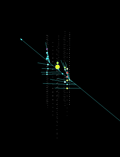 |
|
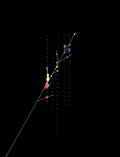 |
|
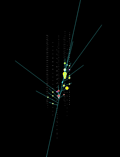 |
|
 Click on any image to animate the
event in new window [gif
format, from 43 to 190 KB] Click on any image to animate the
event in new window [gif
format, from 43 to 190 KB] |
|
# 021328_y |
|
# 1222689_y |
|
# 7492181_y |
|
|
|
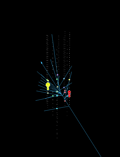 |
|
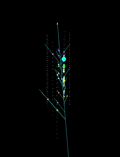 |
|
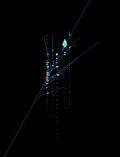 |
|
|
|
# 736486_y |
|
# 3911386_y |
|
# 10604848_y |
|
|
 |
|
For more
details jump to  |
 |
 |
II.
ONLINE TEXTBOOKS AND
LESSONS IN COSMIC RAYS & RELATED SUBJECTS
 |
 |
| Virtual labs, Teacher
pages, and so on [requires Java] |
 |
III.
ADDITIONAL
LINKS
|